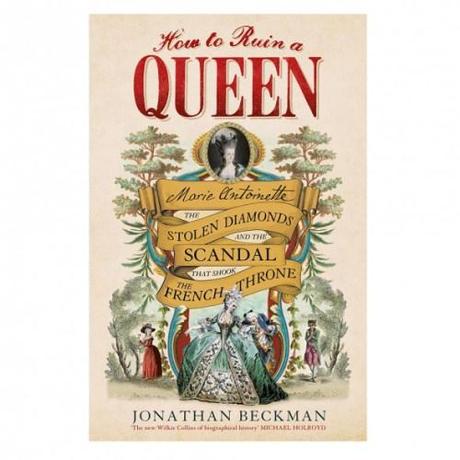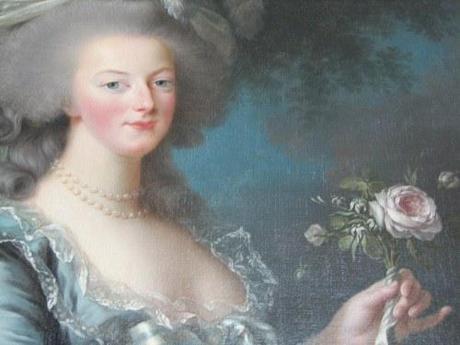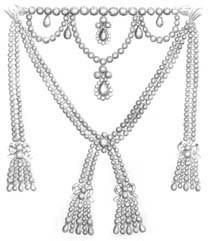
‘On 5 September 1785, a trial began in Paris that would divide the country, captivate Europe and send the French monarchy tumbling down the slope towards the Revolution. Cardinal Louis de Rohan, scion of one of the most ancient and distinguished families in France, stood accused of forging Marie Antoinette’s signature to fraudulently obtain the most expensive piece of jewelry in Europe – a 2,400-carat necklace worth 1.6 million francs.
Where were the diamonds now? Was Rohan entirely innocent? Was, for that matter, the queen? What was the role of the charismatic magus, the Comte de Cagliostro, who was rumoured to be two-thousand-years old and capable of transforming metal into gold?
This is a tale of political machinations and extravagance on an enormous scale; of kidnappings, prison breaks and assassination attempts; of hapless French police disguised as colliers, reams of lesbian pornography and a duel fought with poisoned pigs. It is a detective story, a courtroom drama, a tragicomic farce, and a study of credulity and self-deception in the Age of Enlightenment.‘

Marie Antoinette, Vigée Lebrun. Photo: Musée de Versailles/Melanie Clegg.
There are few historical scandals so glamorous, fascinating and ultimately destructive as the Diamond Necklace Affair that enlivened Parisian gossip in the mid 1780s, showed the hopelessly enervated court of Louis XVI for the flaccid unpopular shambles that it actually was and at the same time hastened the fall from grace of Marie Antoinette and her circle. It’s an astonishing and, at times, hard to believe tale – a collision of thwarted ambitions and unrequited love all played out on a fabulous international stage with a cast that wouldn’t be too out of place in the most preposterously over the top offering by Danielle Steele: the haughty Queen, the desperate jewellers, the ridiculously credulous church magnate, the alleged royal by-blow with delusions of grandeur, the not quite a proper look-a-like prostitute, the shameless mystical adventurer and his backstabbing, illiterate wife.
To my mind, the Diamond Necklace Affair is very much of its time with its hefty dollops of sex, intrigue, mysticism and nice jewelry and like so many scandals of the eighteenth century it also serves as a reminder of how close, socially speaking, we are to our bewigged and panniered forebears – sharing their gaudy, extravagant tastes, their passion for travel, their fascination with gossipy, backstabbing publications. Like a modern day starlet entangled in a scandal, Jeanne de la Motte’s reaction was not to remain enigmatically silent as a Victorian might do, but instead publish her acrimonious and highly questionable memoirs, blaming everyone else for her misfortunes, while well heeled Parisians picked over every trivial detail and pored over pictures of the chief players in the drama.

The infamous diamond necklace. Guys, I’m coming up to my six millionth page view – I’m totally going to celebrate by getting a replica one of these made for myself so that I can FLAUNT it at next year’s blogging events.
It’s a well known tale and one that most students of the period will be well aware of, but I think that Jonathan Beckman’s How to Ruin a Queen: Marie Antoinette, the Stolen Diamonds and the Scandal that Shook the French Throne takes a much needed fresh look at this hoary old story of stolen jewellery, lust and money, while at the same time linking the dramatic events surrounding the infamous necklace with the period in which they happened – finding parallels with the diminishing respect for church and monarchy as well as the increased popularity of popular fiction, most particularly Laclos’ Les Liaisons Dangereuses, which hid darker themes behind its whimsical lightness of touch and subtly expressed a disdain for the upper classes and their acolytes that would explode into full blown revolution within the decade.
I really loved Beckman’s book, finding his wry tone exceedingly amusing and his way of delineating and interpreting the often confusing accounts of events from people obviously determined to blame everyone and anything but themselves both entertaining and, at times, thought provoking. Although he is not, I think, a historian, he shows a clear passion for his subject and his enthusiasm glows throughout, making this a fascinating and engaging read that sweeps the reader along, encouraging them along the way to share in Beckman’s obvious (and clearly occasionally baffled) enjoyment of his material.
If you enjoy my frequent lapses into wry irreverence on this blog then I’m pretty sure you’ll LOVE How To Ruin A Queen as it is written in much the same style, although obviously with greater detail. Fist bumps all round and I can’t wait for Beckman’s next book as I expect it’ll be another corker.
******
Set against the infamous Jack the Ripper murders of autumn 1888 and based on the author’s own family history, From Whitechapel is a dark and sumptuous tale of bittersweet love, friendship, loss and redemption and is available NOW from Amazon UK and Amazon US.
‘Frothy, light hearted, gorgeous. The perfect summer read.’ Minette, my young adult novel of 17th century posh doom and intrigue is now 99p from Amazon UK and 99c from Amazon US. CHEAP AS CHIPS as we like to say in dear old Blighty.
Blood Sisters, my novel of posh doom and iniquity during the French Revolution is just a fiver (offer is UK only sorry!) right now! Just use the clicky box on my blog sidebar to order your copy!
Follow me on Instagram.
